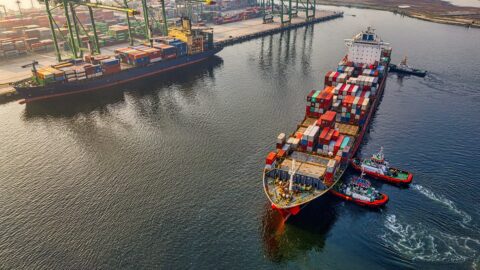At 5.2% y/y, consumer price inflation for the OECD region reached the highest value in October since 1997. Has inflation peaked, or are we at the outset of a sustained period of high inflation? Alongside the pandemic, inflation will be one of the key drivers of the economy and the financial markets next year.
Specific circumstances
The pandemic, in turn, is one of the key drivers of the current high inflation rates. The pandemic constitutes a massive external shock, and the normal state of affairs has been deviated from across many levels. This includes the healthcare system, economic key ratios such as GDP and inflation, and even the general attitude towards solidarity, liberal democracy, and the rule of law.
At the same time, the most basic economic relationship still holds: if supply cannot keep up with rising demand, prices will increase.
Slump in demand
In the wake of the outbreak of the pandemic, another driving factor has emerged for economic activity: the negative impact of new infections on growth.
It is exacerbated by measures aimed at social distancing (lockdown). This effect was particularly significant last year during the first wave of infections. The slump of the GDP within two or three months was so dramatic that global average GDP came in significantly below the 2019 referential figure. i.e. 3.4% p.a. according to the OECD.
Something similar happened to energy demand, which fell by 4% (source: IEA). On the labour market, the amount of work hours decreased in Q2 2020 between 12% to 21% relative to Q4 2019 (source: BIS). Since WWII, such spikes have been unique.

“The pandemic, in turn, is one of the key drivers of the current high inflation rates. The pandemic constitutes a massive external shock, and the normal state of affairs has been deviated from across many levels.”
Gerhard Winzer, Chief-Economist
© Bild: Erste AM
Rapid improvement of demand
Locking down is easier than opening up (again). When the first infection wave had subsided, the economy recorded a mercurial recovery. The OECD expects GDP growth of 5.6% for this year, while the IEA envisages an increase in global energy demand of 4.6%, and according to the BIS, the number of hours worked in Q2 2021 were only 5% below pre-pandemic levels anymore.
Also, the recovery has not been equally distributed in terms of countries or sectors, and the global economy is linked into a giant network (supply chains). The demand for consumer goods is particularly remarkable, having already exceeded pre-pandemic levels.
Bottlenecks
Supply failed to keep up with the quick and uneven increase in demand, which resulted in bottlenecks across various levels, i.e. in components (semiconductors), transport (shipping), the energy sector (natural gas, crude oil, coal), and on the labour market.
The consequences are limited production volumes, high inflation rates, hurdles to building inventories, and a loss in purchase power. This is where the stagflationary effect of the pandemic manifests itself.
High inflation
Inflation had already been expected to rise at the beginning of the year due to the low price increases last year. The base effect has led to rising inflation rates on a year-on-year basis. However, the bottlenecks created by the rapid rise in demand for goods and energy came as a surprise and have caused the prices of consumer goods, transport, and energy to soar.
As for the energy sector, one crucial issue is also the fact that in recent years investment in fossil energy carriers had been on the decline, but at the same time investments in climate-friendly energy carriers had been left wanting. The rise in food prices was due, among other things, to the increase in energy and transport costs.
Base case scenario: inflation does not fall back to pre-pandemic levels
The phase of high inflation takes longer than expected at the beginning of the year. More and more economists and central bankers stop talking about a “transitory” development (after all, everything is). Every new, serious virus variant harbours the risk of new distortions between supply and demand with according price increases.
In the base case scenario, the currently high inflation rates will fall next year, because the reason for the high inflation will be subsiding gradually, i.e. the imbalances between supply and demand caused by the pandemic.
The high demand for goods is likely to normalise, and the bottlenecks in production and logistics will be gradually resolved. However, the combination of a rapidly closing negative output gap (rapidly falling unemployment rates), above-potential growth, and the only gradual normalisation of the monetary policy have an inflationary effect.
Therefore, in the base case scenario the underlying inflation rate will remain above the pre-pandemic level. We expect to see a Q4 2021 inflation rate of about 5% (annualised q/q data) for the developed economies. For Q4 2022, we forecast an inflation rate of 2% to 2.5% (also annualised). A few questions will need to be answered:
Inflationary forces
In addition to the pandemic, are there any other structural forces that affect inflation? The risks of a structurally rising inflation rate are linked to three areas:
- The expansive monetary and fiscal policies could remain expansive (i.e. supportive to the economy) for too long, also after full employment has been reached. The outbreak of the pandemic has led to a changed political economy. The focus is, understandably, on employment and higher inflation (because it has been below the central bank target in the past ten years).
- The deflationary pressure on the prices of goods that emerged on the back of the opening of China and stayed in place for two decades could have permanently ceased to apply. Globalisation stagnates or could even permanently reverse (deglobalisation). The China effect (booming exports, falling prices of goods) has lost momentum.
- At the same time, the change in the age structure of the population could support inflation. The size of the employable part of the population has been on the decline across countries. This could lead to higher wage inflation. From a long-term perspective, the development of unit wage costs is the most important measuring unit for inflation.
Exit from the ultra-expansive monetary policy
How will central banks react to the development of inflation? Generally speaking, the less solidly inflation expectations are anchored at the central bank target, the more quickly the unemployment rate approaches full employment (“Non-Accelerating Inflation Rate of Unemployment”), and the more permanently the supply side is impaired (decline in the participation on the labour market, deglobalisation), the more rapidly the key-lending rates will be raised towards the neutral levels in the developed economies.
As for the US central bank, we envisage an end of its bond purchase programme for next spring and three interest rate hikes throughout the year. In the base case scenario, the ECB will leave its key-lending rates unchanged, but it will prepare the market participants for its abandonment of the zero-interest rate policy in 2023.
Conflict of goals
For the coming year, another central topic is emerging alongside the pandemic. If inflation does not fall, the conflict of goals among the central banks will intensify. In this case, the central banks would come under pressure to raise interest rates more significantly and earlier than expected.
But restrictive monetary measures would negatively affect the target parameters of growth, employment, financial stability and, for the ECB, the integrity of the Eurozone. On the upside, even though the elevated inflation is really not a transitory one anymore, inflation rates will be gradually falling next year in the base case scenario. It is up to the central bankers to reduce the ultra-expansive stance at the commensurate speed.
Legal note:
Prognoses are no reliable indicator for future performance.
Legal disclaimer
This document is an advertisement. Unless indicated otherwise, source: Erste Asset Management GmbH. The language of communication of the sales offices is German and the languages of communication of the Management Company also include English.
The prospectus for UCITS funds (including any amendments) is prepared and published in accordance with the provisions of the InvFG 2011 as amended. Information for Investors pursuant to § 21 AIFMG is prepared for the alternative investment funds (AIF) administered by Erste Asset Management GmbH pursuant to the provisions of the AIFMG in conjunction with the InvFG 2011.
The currently valid versions of the prospectus, the Information for Investors pursuant to § 21 AIFMG, and the key information document can be found on the website www.erste-am.com under “Mandatory publications” and can be obtained free of charge by interested investors at the offices of the Management Company and at the offices of the depositary bank. The exact date of the most recent publication of the prospectus, the languages in which the fund prospectus or the Information for Investors pursuant to Art 21 AIFMG and the key information document are available, and any other locations where the documents can be obtained are indicated on the website www.erste-am.com. A summary of the investor rights is available in German and English on the website www.erste-am.com/investor-rights and can also be obtained from the Management Company.
The Management Company can decide to suspend the provisions it has taken for the sale of unit certificates in other countries in accordance with the regulatory requirements.
Note: You are about to purchase a product that may be difficult to understand. We recommend that you read the indicated fund documents before making an investment decision. In addition to the locations listed above, you can obtain these documents free of charge at the offices of the referring Sparkassen bank and the offices of Erste Bank der oesterreichischen Sparkassen AG. You can also access these documents electronically at www.erste-am.com.
Our analyses and conclusions are general in nature and do not take into account the individual characteristics of our investors in terms of earnings, taxation, experience and knowledge, investment objective, financial position, capacity for loss, and risk tolerance. Past performance is not a reliable indicator of the future performance of a fund.
Please note: Investments in securities entail risks in addition to the opportunities presented here. The value of units and their earnings can rise and fall. Changes in exchange rates can also have a positive or negative effect on the value of an investment. For this reason, you may receive less than your originally invested amount when you redeem your units. Persons who are interested in purchasing units in investment funds are advised to read the current fund prospectus(es) and the Information for Investors pursuant to § 21 AIFMG, especially the risk notices they contain, before making an investment decision. If the fund currency is different than the investor’s home currency, changes in the relevant exchange rate can positively or negatively influence the value of the investment and the amount of the costs associated with the fund in the home currency.
We are not permitted to directly or indirectly offer, sell, transfer, or deliver this financial product to natural or legal persons whose place of residence or domicile is located in a country where this is legally prohibited. In this case, we may not provide any product information, either.
Please consult the corresponding information in the fund prospectus and the Information for Investors pursuant to § 21 AIFMG for restrictions on the sale of the fund to American or Russian citizens.
It is expressly noted that this communication does not provide any investment recommendations, but only expresses our current market assessment. Thus, this communication is not a substitute for investment advice.
This document does not represent a sales activity of the Management Company and therefore may not be construed as an offer for the purchase or sale of financial or investment instruments.
Erste Asset Management GmbH is affiliated with the Erste Bank and austrian Sparkassen banks.
Please also read the “Information about us and our securities services” published by your bank.


